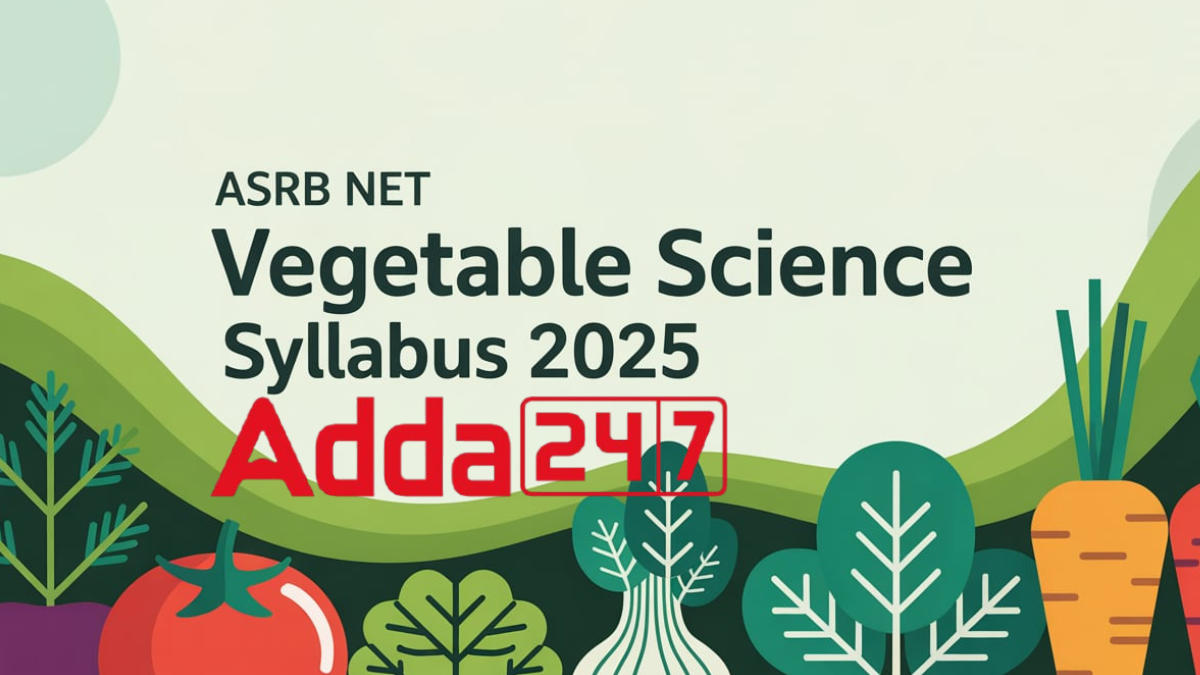Table of Contents
Candidates need to choose a specific discipline for the ASRB NET Exam 2025. Vegetable Science, a popular discipline, includes important areas such as the origin and classification of vegetables, improved varieties, crop production techniques, seed production, post-harvest handling, and biotic and abiotic stress management. The exam evaluates both theoretical understanding and practical knowledge in the desired domain. The given article provides a unit-wise detailed ASRB NET Vegetable Science Syllabus 2025.
ASRB NET Vegetable Science Exam Pattern 2025
The ASRB NET Vegetable Science Exam follows a structured pattern designed to assess candidates’ subject knowledge and research aptitude. The exam consists of a single paper with 150 objective-type multiple-choice questions, each carrying one mark, totaling 150 marks. The duration of the exam is two hours, and there is a penalty of one-third mark for every incorrect answer.
| Exam Pattern For ASRB NET Vegetable Science | |
| Conducting Body | Agriculture Scientist Recruitment Board (ASRB) |
| Exam Name | ASRB NET |
| Exam Level | National |
| Exam Frequency | Once a year |
| Exam Mode | Online |
| Exam Duration | 2 Hours |
| Total number of Questions | 150 |
| Maximum Marks | 150 |
| Official Website | asrb.org.in |
| Negative Marking | 1/3 mark deducted for each incorrect answer |
ASRB NET Vegetable Science Syllabus 2025
The ASRB NET Vegetable Science Syllabus covers a wide range of topics, including the production technology of cool-season vegetable crops, production technology of warm-season vegetable crops, breeding, growth & development, seed production, systematics of vegetable crops, etc. The detailed unit-wise ASRB NET Syllabus for Vegetable Science has been discussed in the given section.
Unit 1: Production Technology of Cool-Season Vegetable Crops
Introduction, botany and taxonomy, climatic and soil requirements, commercial varieties/hybrids, sowing/ planting times and methods, seed rate and seed treatment, nutritional and irrigation requirements, intercultural protection measures and seed production of: Potato, Cole crops: cabbage, cauliflower, knol khol, sprouting broccoli, Brussels sprout, Root crops: carrot, radish, turnip, and beetroot, Bulb crops: onion and garlic, Peas and broad bean, Green leafy vegetables (spinach, palak, fenugreek and coriander).
Unit 2: Production Technology of Warm-Season Vegetable Crops
Introduction, botany and taxonomy, climatic and soil requirements, commercial varieties/hybrids, sowing/planting times and methods, seed rate and seed treatment, nutritional and irrigation requirements, intercultural operations, weed control, mulching, physiological disorders, harvesting, post harvest management, plant protection measures, economics of crop production and seed production of: Tomato, eggplant, hot and sweet peppers, Okra, beans, cowpea and cluster bean, Cucurbitaceous crops, Tapioca and sweet potato, Green leafy vegetables(amaranthus, sorrel, rosella, and portulaca), and moringa.
Unit 3: Breeding of Vegetable Crops
History and evolutionary aspects of vegetable breeding, origin, botany, taxonomy, genetic resources, wild relatives, cytogenetics, genetics, breeding objectives, pollination and fertilization mechanisms, techniques of selfing and crossing; Breeding systems; breeding methods for self and cross pollinated vegetables (introduction, selection, pedigree, hybridization, mutation, and polyploidy breeding),heterosis breeding- types, mechanisms, and basis of heterosis, inbreeding depression, facilitating mechanisms like male sterility, self-incompatibility, and sex forms; varieties and varietal characterization, resistance breeding for biotic and abiotic stress, quality improvement, synthetic breeding, Speed breeding, rootstock breeding, biofortification, parthenocarpy, improvement of asexually propagated vegetable crops, breeding for protected environment, ideotype breeding; doubled haploid technique, gene pyramiding, pre-breeding, molecular marker, genomics, genome editing, marker-assisted breeding and QTLs, biotechnology, and their use in breeding, Issue of patenting, PPV& FR Act, varietal release procedure; DUS testing in vegetable crops; potato, tomato,
eggplant, hot pepper, sweet pepper, okra, peas and beans, amaranth, chenopods, lettuce, fenugreek, coriander, gourds, melons, pumpkins and squashes, cabbage, cauliflower, Brussels, sprout, broccoli, carrot, beetroot, radish, onion, sweet potato, taro, yam, and tapioca.
Unit 4. Growth and Development of Vegetable Crops
Cellular structures and their functions; definition of growth and development, phases of growth, growth analysis and its importance in vegetable production; Physiology of dormancy and germination of vegetable seeds, tubers, and bulbs; role of auxins, gibberellins, cytokinins ethylene, abscisic acid and bassinosteroids; application of synthetic hormones, plant growth retardants and inhibitors for various purposes in vegetable crop, role and mode of action of morphactins, antitranspirants, anti-auxin, ripening retardant,s and plant stimulants in vegetable crop production; Role of light, temperature, and photoperiod on growth, development of underground parts, flowering and sex expression in vegetable crops, including cucurbits; apical dominance; physiology of fruit set, fruit development, fruit growth, flower and fruit drop; parthenocarpy in vegetable crops; vernalisation, photoperiodism, phototropism, ethylene inhibitors, senescence and abscission; fruit ripening and physiological changes associated with ripening; plant growth regulators in relation to vegetable production; morphogenesis and tissue culture techniques in vegetable crops. Checking flower and fruit drops and improving fruit set in Solanaceous vegetables.
Unit 5: Seed Production of Vegetable Crops
Introduction; Seed history of vegetable seed production, definition of seed and its quality, modes of propagation in vegetables; Seed morphology, development, and maturation in vegetable seeds; Apomixis and fertilization; Modes of propagation and reproductive behavior; Pollination mechanisms and sex forms in vegetables; Deterioration of crop varieties, genetical and agronomic principles of vegetable seed production; Seed village concept. Floral biology; classification of vegetable crops based on pollination and reproduction behavior; steps in quality seed production; identification of suitable areas/locations for seed production; Classification based on growth cycle and pollination behavior; methods of seed production, TPS (true potato seed), comparison between different seed production methods, seed multiplication ratios, and replacement rate in vegetables; pollination mechanisms; sex types, ratios, and expression and modification of sex and flowering pattern in cucurbits; nursery raising and transplanting stage; Seed production technology of vegetables viz., solanaceous, cucurbitaceous, leguminous, malvaceous, Cole crops, leafy vegetables,
root, tuber, and bulb crops and seed spices; harvesting/picking stage and seed extraction in fruit vegetables; clonal propagation and multiplication in tuber crops e.g. Potato, sweet potato, Colocasia, tapioca; seed-plot technique in potato tuber seed production; hybrid seed production technology of
vegetable crops, and its production technique; hybrids in vegetables; maintenance of parental lines; use of male sterility and self-incompatibility in hybrid seed production, environmental factors related to flowering/bolting in vegetable crops; generation system of seed multiplication; maintenance and production of nucleus, breeder, foundation, certified/ truthful label seeds; seed quality and mechanisms of genetic purity testing. maturity standards; seed harvesting, curing and extraction; seed processing, viz., cleaning, drying, and treatment of seeds, seed health and quality enhancement, packaging and marketing; principles of seed storage; orthodox and recalcitrant seeds; field and seed standards, importance and present status of the vegetable seed industry, and share of vegetable seeds in seed industry; intellectual property rights and its implications, impact of PVP on growth of seed industry.
Unit 6: Systematics of Vegetable Crops
Principles of classification; different methods of classification; salient features of international code of nomenclature of vegetable crops; origin, history, evolution, and distribution of vegetable crops, botanical description of families, genera, and species covering various vegetables; morphological keys to identify important families, floral biology, floral formula, and diagram; morphological description of all parts of vegetables; cytological level of various vegetable crops; descriptive keys for important vegetables; importance of molecular markers in evolution of vegetable crops; molecular markers as an aid in characterization and taxonomy of vegetable crops.
Unit 7: Production of Underutilized Vegetable Crops
Introduction, importance, and scope of underutilized vegetable crops, botany and taxonomy, climatic and soil requirements, commercial varieties/hybrids, nursery techniques viz.(sowing/planting times and methods, seed rate and seed treatment, nutritional and irrigation requirements, intercultural operations, weed control, mulching), physiological disorders, harvesting, post-harvest management, plant protection measures: Asparagus, artichoke, and leek, Chinese cabbage, kale and artichoke, celery, parsley, parsnip, lettuce, rhubarb, bathu/chenopods, chekurmanis, elephant foot yam, lima bean, winged bean, vegetable pigeon pea, jack bean and scarlet runner bean, sword bean, sweet gourd(Kakrol), spine gourd (Kartoli), pointed gourd, Oriental pickling melon, little gourd (kundru), Taro, Tannia, and Chinese potato.
Unit 8: Post-Harvest Management of Vegetable Crops
Importance and scope of post-harvest management of vegetables; maturity indices and standards for different vegetables; methods of maturity determinations, biochemistry of maturity and ripening, enzymatic and textural changes, ethylene evolution and ethylene management, respiration,
transpiration, Harvesting tools, harvesting practices for specific market requirements; post-harvest physiological and biochemical changes, storage disorders – chilling and freezing injury in vegetables, influence of pre-harvest practices and other factors affecting post-harvest losses,
packaging house operations, pre-cooling- methods of precooling commodity pretreatmentschemicals, wax coating, prepackaging, and irradiation; packaging of vegetables, post-harvest diseases and prevention from infestation, principles of transport; Methods and practices of storage ventilated, refrigerated, MA & CA storage, hypobaric storage, and cold storage, zero energy cool chamber; storage disorders.
Unit 9: Organic Vegetable Production
Importance, principles, perspective, concepts, and components of organic farming in vegetable crops. Organic production of vegetable crops viz., Solanaceous, Cucurbitaceous, Cole, root, and tuber crops. Managing soil fertility, mulching, raising green manure crops, weed management, crop
rotation, and crop diversification in organic production; quality control of organic vegetable produce. Indigenous methods of composting, bioformulations, Panchyagavvya, biodynamics preparations and their application; ITKs in organic vegetable farming; concentrated organic manures, crop residues, agro industrial wastes; Role of botanicals and bio-control agents in the management of pests and diseases in vegetable crops. Techniques of natural vegetable farming, GAP and GMP certification of organic products; organic vegetable seed production; processing, export opportunities, and challenges in organic vegetable production.
Unit 10: Protected Cultivation of Vegetable Crops
Concept, scope, and importance of protected cultivation of vegetable crops; Principles, design, orientation of structure, low and high-cost polyhouses/greenhouse structures. Classification and types of protected structures: greenhouse/polyhouses, plastic-non-plastic low tunnels, plastic walk-in tunnels, high roof tunnels with ventilation, insect-proof net houses, shade net houses, rain shelters, naturally ventilated polyhouse, climate-controlled greenhouses, vertical farming, hydroponics and aeroponics; soil and soilless media for bed preparation; design and installation of drip irrigation and fertigation system, use of IoT and digital technologies, Effect of environmental factors and manipulation of temperature, light, carbon dioxide, humidity on growth and yield of different vegetables under protected cultivation. Climate control and automation. High-tech vegetable nursery raising: Nursery problems and their management. Regulation of flowering and fruiting in vegetable crops; Technology for raising tomato, sweet pepper, cucumber, cabbage, cauliflower, broccoli, and off-season leafy vegetables in protected structures, including varieties and hybrids, training, pruning, and staking in growing vegetables under protected structures. Problems of growing vegetables in protected structures and their remedies, physiological disorders, insect and disease management in protected structures; Use of protected structures for seed production; Economics of greenhouse crop production.
Unit 11: Processing of Vegetable Crops
Present status and prospects of the vegetable preservation industry in India. Spoilage of fresh and processed vegetable produce; biochemical changes and enzymes associated with spoilage of vegetable produce; Principal spoilage organisms, food poisoning, and their control measures; Role of microorganisms in food preservation. Raw material for processing; Primary and minimal processing; processing equipment; Layout and establishment of processing industry; FPO license; Importance of hygiene; Plant sanitation. Quality assurance and quality control, Food standards FPO, PFA, etc.; Food laws and regulations; Food safety- Hazard analysis and critical control points (HACCP), Labeling and labeling act, and nutrition labeling. Major value-added vegetable products; Dehydration- methods, canning, pickling- spoilage of pickles; Utilization of byproducts of vegetable processing industry; Management of processing industry waste; Investment analysis; Principles and methods of sensory evaluation of fresh and processed vegetables.
Preparation Tips for ASRB NET Vegetable Science Exam 2025
Preparing for the ASRB NET in Vegetable Science can be done with the right strategy. Here are some practical and effective tips to help candidates boost their preparation.
- Start with a Clear Roadmap: Break down the syllabus into bite-sized chunks. Create a study schedule that’s flexible but consistent—think of it as the personalized roadmap to success. Map out key topics and allocate study time in a way that balances both the strengths and areas that need to work on.
- Master the Fundamentals Before the Details: Vegetable Science is a subject that builds on core principles like plant biology, crop management, and environmental factors. Master these fundamentals first once they’re crystal clear, the more complex topics will feel like a natural extension.
- Hands-On Learning Through Experiments: Whenever possible, try to engage with practical examples, case studies, or real-life experiments related to vegetable cultivation. Understanding how theories play out in real-life scenarios will deepen the retention and make studying less of a chore.
- Engage in Active Recall & Spaced Repetition: Instead of passive reading, quiz yourself on what you have been learnt. Active recall helps boost memory, and using spaced repetition will ensure that aspirants don’t forget key concepts just when they need them the most.
- Visual Learning: Use images, charts, and videos to understand complex topics better. For example, visualizing the stages of plant growth or irrigation methods will enhance the conceptual understanding and make revision much easier.
- Focus on Quality Over Quantity: Instead of cramming endless information, focus on mastering fewer, more important topics. It’s better to have in-depth knowledge of essential areas than to skim through every single detail.
| Related Posts |
|
| ASRB NET Previous Year Paper | ASRB NET Agronomy Syllabus |





 Rajasthan 4th Grade Syllabus 2025 and Ne...
Rajasthan 4th Grade Syllabus 2025 and Ne...
 TNPSC Group 4 Syllabus 2025 And Exam Pat...
TNPSC Group 4 Syllabus 2025 And Exam Pat...
 Rajasthan Patwari Syllabus 2025 and Exam...
Rajasthan Patwari Syllabus 2025 and Exam...


 Adda247 Job portal has complete information about all Sarkari Jobs and Naukri Alerts, its latest recruitment notifications, from all state and national level jobs and their updates.
Adda247 Job portal has complete information about all Sarkari Jobs and Naukri Alerts, its latest recruitment notifications, from all state and national level jobs and their updates.